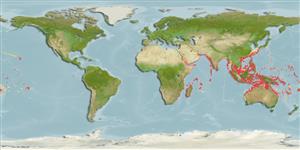>
Eupercaria/misc (Various families in series Eupercaria) >
Lutjanidae (Snappers) > Lutjaninae
Etymology: Lutjanus: Malay, ikan lutjan, name of a fish.
More on author: Cuvier.
Environment: milieu / climate zone / depth range / distribution range
ນິເວດວິທະຍາ
ສັດທະເລ ກ່ຽວກັນຫີນ; ລະດັບຄວາມເລິກ 3 - 150 m (Ref. 9773). Tropical; 35°N - 31°S, 31°E - 145°W (Ref. 55)
Indo-Pacific: East Africa to Tahiti, north to southern Japan, south to Australia.
Length at first maturity / ຂະໜາດ / ນ້ຳໜັກ / Age
Maturity: Lm ?, range 37 - ? cm
Max length : 81.1 cm TL ຕົວຜູ້/ບໍ່ມີເພດ; (Ref. 132181); common length : 60.0 cm TL ຕົວຜູ້/ບໍ່ມີເພດ; (Ref. 5450); ນ້ຳໜັກສູງສຸດທີ່ເຄຍຈັດພີມມາ: 11.0 kg (Ref. 9710)
ຄີ (ໜາມ)ແຂງຢູ່ຫຼັງປາ (ທັງໝົດ) : 10; ຄີຫຼັງຂອງປາ (ຄີອ່ອນ) (ທັງໝົດ) : 15 - 16; ຄີ(ໜາມ) ແຂງຢູ່ຄີກົ້ນປາ
ກຸ່ມປາກະດູກແຂງ
ຄວາມຖີ່ຂອງກຸ່ມຖ່າຍທອດພັນ
ປາທີ່ມີການເຄື່ອນຍ້າຍຈາກທະເລໄປຫານ້ຳຈືດ ແລະນ້ຳຈືດຫາທະເລ
ປາທີ່ມີການເຄື່ອນຍ້າຍຈາກທະເລແລະໄປໄຂ່ຢູ່ນ້ຳຈືດ
ຄີກົ້ນຂອງປາ
ສັດທີ່ມີກະດູກສັນຫັຼງ
ການຖ່າຍທອດທາງກຳມະພັນຈາກພໍ່ແມ່ຫາລູກ: 3; ຄີກົ້ນຂອງປາ: 8. This species is distinguished by the following characters: body very deep, greatest depth 2.1-2.4 in SL; lips greatly thickened in adults; preopercular notch and knob moderately developed; vomerine tooth patch crescentic, without a medial posterior extension; tongue smooth, no teeth; gill rakers of first gill arch 6 + 11-12 =17-18; caudal fin truncate or slightly emarginate. Colour generally brown with a reddish tinge; each scale on side with a pale
brown border and 2-3 small bluish white spots in central portion; head with numerous undulating blue lines; lips tan; fins largely yellowish to dusky grey-brown; juveniles with a series of 3-8 brown bars on sides and a chalky white spot, with a broad blackish margin, present below anterior soft dorsal-fin rays at level of lateral line, preceded by similar-sized black spot on middle of side (Ref. 9821, 90102).
Occasionally encountered in coral reefs or shallow inshore flats (Ref. 30573). Found singly or in small groups (up to 15 to 20 individuals). Adults on deep coastal slopes; juveniles on shallow algae-reef flats, often near freshwater run-offs (Ref. 48635). Feed on fishes, cephalopods and benthic crustaceans (Ref. 30573). An excellent food fish. In Hong Kong live fish markets (Ref. 27253). Caught with handlines, traps, and gill nets, occasionally trawled; important to artisanal fisheries and marketed mostly fresh (Ref. 9821). Minimum depth reported taken from Ref. 57178.
Life cycle and mating behavior
ການຈະເລີນເຕັມໄວ | ການສືບພັນ | ການວາງໄຂ່ | ໄຂ່ | ຄວາມດົກຂອງໄຂ່ປາ | ຕົວອ່ອນ
Allen, G.R., 1985. FAO Species Catalogue. Vol. 6. Snappers of the world. An annotated and illustrated catalogue of lutjanid species known to date. FAO Fish. Synop. 125(6):208 p. Rome: FAO. (Ref. 55)
IUCN Red List Status (Ref. 130435: Version 2024-1)
Threat to humans
Reports of ciguatera poisoning (Ref. 30298)
Human uses
ການປະມົງ: ເປັນສີນຄ້າ; ການລ້ຽງສັດນ້ຳ: ເປັນສີນຄ້າ; ຊະນິດປາທີ່ຖືກນຳໃຊ້ເຂົ້າໃນການຫາເພື່ອເປັນເກມກິລາ: ແມ່ນ
ເຄື່ອງມື
Special reports
Download XML
ແຫຼ່ງອີນເຕີເນັດ
Estimates based on models
Preferred temperature (Ref.
123201): 22.5 - 28.2, mean 26.5 °C (based on 353 cells).
Phylogenetic diversity index (Ref.
82804): PD
50 = 0.5000 [Uniqueness, from 0.5 = low to 2.0 = high].
Bayesian length-weight: a=0.01549 (0.00893 - 0.02686), b=3.02 (2.88 - 3.16), in cm total length, based on LWR estimates for this species & Genus-body shape (Ref.
93245).
ຊັ້ນເຂດຮ້ອນ (Ref.
69278): 4.0 ±0.51 se; based on food items.
ຄວາມຢືດຢຸ່ນ (Ref.
120179): ຂະໜາດກາງ, ປະຊາກອນຕຳ່ສຸດທີ່ໃຊ້ເວລາສອງເທົ່າ 1.4 - 4.4 ປີ (K=0.22).
Fishing Vulnerability (Ref.
59153): High vulnerability (62 of 100).
Nutrients (Ref.
124155): Calcium = 24.1 [15.5, 34.5] mg/100g; Iron = 0.291 [0.189, 0.438] mg/100g; Protein = 18.7 [17.2, 20.0] %; Omega3 = 0.131 [0.093, 0.177] g/100g; Selenium = 74.5 [51.6, 106.8] μg/100g; VitaminA = 110 [21, 389] μg/100g; Zinc = 0.367 [0.300, 0.499] mg/100g (wet weight);
